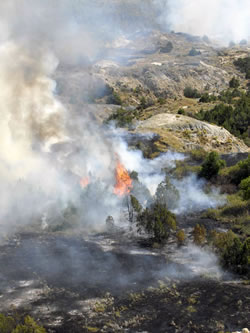National Cohesive Wildland Fire Management Strategy Success Story
Midwest Parks Collaborate to Accomplish Prescribed Fire Goals
Theodore Roosevelt National Park, North Dakota
Agate Fossil Beds National Monument, Nebraska
Cohesive Strategy - Maintain and Restore Landscapes
2011

Encroachment by junipers has lead to increased fuel loading in Theodore Roosevelt National Park. The use of prescribed fire has helped to restore native plants and reduce the possibility of an uncontrollable wildfire. NPS photo.
Managers and fire personnel from several Northern Great Plains area parks recently came together to conduct the Sheep Prescribed Fire, a large prescribed fire in the wilderness/badlands area of Theodore Roosevelt National Park’s North Unit. Red-carded employees from Wyoming, North Dakota, and South Dakota parks in addition to the U.S. Fish & Wildlife Service, U.S. Forest Service and The Nature Conservancy participated in this collaborative effort. Overall, more than forty people were involved in this 3,618 acre burn, each essential to implementing the prescribed fire safely.
The objectives for the Sheep Prescribed Fire included fire ecology and restoration actions like reducing fuel loads, improving foraging and lambing habitat for Bighorn Sheep, slowing juniper encroachment, and ultimately, to restore fire to its natural role in the fire-dependent ecosystem. Theodore Roosevelt Park Superintendent, Valerie Naylor affirmed the prescribed fire objectives, stating “fire is a natural process… NPS policy stresses managing fire for resource benefits rather than merely suppressing it.”
Shortly after finishing the Sheep Prescribed Fire, fire personnel moved on to complete a second prescribed fire in Theodore Roosevelt’s Longhorn Flats unit, which totaled 413 acres. This burn was also very successful at reducing density and cover of sage brush in order to enhance native grass forage for the national park’s resident Longhorn cattle.
Fire personnel then traveled nine hours south to Agate Fossil Beds National Monument near Harrison, Nebraska to complete the third and final prescribed fire at the North Carnegie unit. According to NPS records, eighty percent of this 464 acre area had not been burned in 25 years. The aim for this prescribed fire was to decrease thatch accumulation by reintroducing fire, and in so doing, reinvigorate the native prairie composition. Volunteers from Harrison Volunteer Fire Department provided valuable local knowledge as well as operational support necessary to complete a burn that was cost effective and efficient.
In total the three burn units successfully treated 4,495 acres. These prescribed fires are considered a great accomplishment by the parks and individuals involved, demonstrating the collaboration that is possible when agencies and volunteers partner together to reach mutually beneficial goals.
Contact
Leah Mitchell, Fire Administration, Northern Great Plains Fire Management
Email: Leah_Mitchell@nps.gov
Phone: (605) 745-1192
Keywords: Cost Effective and Efficient, Fire Ecology and Restoration